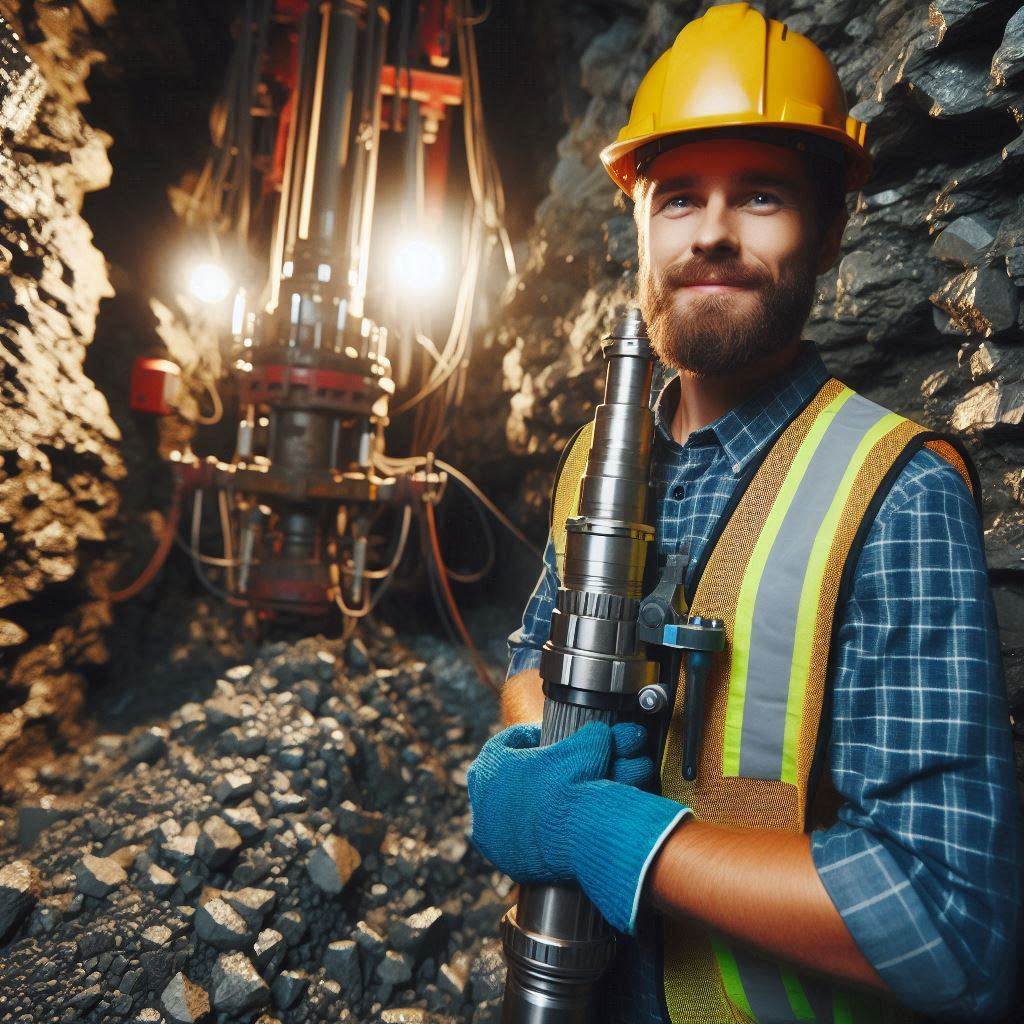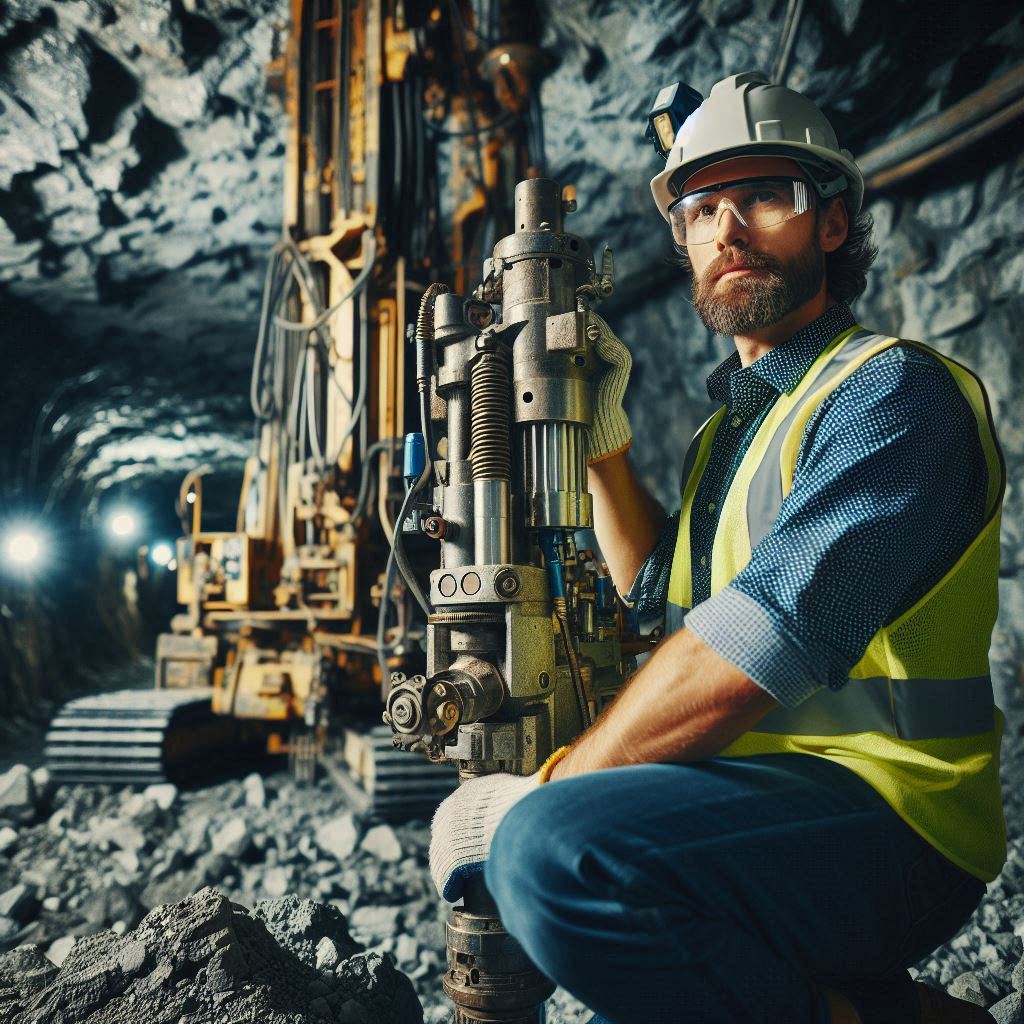Introduction
The role of geology in mining engineering is crucial.
Geology informs the discovery, extraction, and management of mineral resources.
This blog will explore geology’s importance in mining, focusing on key aspects.
The Role of Geology in Mining Engineering
Geology is fundamental to mining engineering.
It studies the Earth’s structure, composition, and processes.
Mining engineers rely on geology to locate and assess mineral deposits.
By understanding geological formations, engineers can determine the best methods for mineral extraction.
This ensures efficient and safe mining operations.
Geology also helps in predicting and mitigating mining-related hazards.
Thus, geology is indispensable in mining engineering.
The Importance of Geology in the Mining Industry
Geology plays a pivotal role in the mining industry.
It helps identify potential mining sites through geological surveys and mapping.
These surveys reveal the presence and quantity of minerals.
Accurate geological data minimizes the risk of unsuccessful mining ventures.
Geologists analyze rock formations to determine the most cost-effective and safe extraction techniques.
They also monitor geological conditions during mining to prevent accidents.
By understanding the geology of a site, mining operations can be optimized for maximum productivity and safety.
In summary, geology ensures the sustainability and profitability of mining projects.
Overview of What Will Be Discussed in the Blog Post
This blog will discuss geology’s role in various stages of mining engineering.
It will cover how geological surveys and mapping are conducted.
The importance of mineral exploration and resource estimation will be highlighted.
We will explore the role of geology in mine design and planning.
Additionally, the blog will address how geology aids in environmental management and mine safety.
By the end, you will understand geology’s integral role in every aspect of mining engineering.
What is Geology?
Geology and Its Significance in Mining Engineering
Geology is the study of the Earth’s physical structure, substances, history, and processes.
It plays a critical role in mining engineering by helping engineers locate and extract minerals efficiently and safely.
Understanding geology allows mining engineers to predict where mineral deposits are likely to be found.
This knowledge reduces the risk of drilling in unproductive areas, saving time and resources.
Additionally, geology informs engineers about the stability of the ground, which is essential for ensuring the safety of mining operations.
By studying the geological formations, mining engineers can plan the most effective methods for extracting minerals while minimizing environmental impact.
This close relationship between geology and mining engineering underscores the importance of geological knowledge in the field.
The Different Branches of Geology That Are Relevant to Mining
Several branches of geology are particularly relevant to mining engineering.
Economic geology focuses on the study of mineral deposits and the economic considerations of mining.
It helps engineers evaluate the feasibility of mining projects by assessing the quantity and quality of the mineral resources.
Structural geology examines the Earth’s structure, including the arrangement of rocks and their deformation patterns.
This knowledge is crucial for understanding the stability of mining sites and planning safe extraction methods.
Petrology, the study of rocks, helps identify the types of rocks that host valuable minerals.
By understanding the characteristics of these rocks, mining engineers can develop strategies to efficiently extract the minerals.
Hydrogeology, the study of groundwater, is also important in mining.
It helps engineers manage water resources and address issues such as mine flooding and water contamination.
By integrating knowledge from these various branches of geology, mining engineers can make informed decisions that enhance the efficiency and safety of mining operations.
Read: The Role of Aerospace Engineers in Satellite Development
Importance of Geology in Mining Engineering
How geology helps in identifying potential mining sites.
Geology plays a crucial role in mining engineering by identifying potential mining sites.
Geologists study the Earth’s crust to locate mineral-rich areas.
They analyze rock formations and geological structures to determine where valuable minerals may be found.
This process involves extensive fieldwork, including mapping and sampling.
Geologists use various techniques like remote sensing and geophysical surveys to gather data.
This information helps in pinpointing areas with high mineral potential.
Identifying these sites accurately is essential for the success of mining projects.
Geology ensures that resources are not wasted on unproductive areas.
The role of geology in determining the type of minerals present in a particular location.
Geology helps determine the type of minerals present in a particular location.
Different geological conditions lead to the formation of specific minerals.
Geologists study the composition and structure of rocks to identify these conditions.
By analyzing rock samples, they can determine the mineral content.
Techniques like X-ray diffraction and mass spectrometry are used for detailed analysis.
Understanding the mineral composition is crucial for mining operations.
It informs the extraction methods and processing techniques required.
Accurate identification of minerals ensures efficient and profitable mining operations.
How geology helps in assessing the economic viability of mining projects.
Geology is vital in assessing the economic viability of mining projects.
It provides essential data on the quantity and quality of mineral deposits.
Geologists estimate the size of the deposit through drilling and sampling.
They also assess the concentration of valuable minerals.
This information is crucial for determining the potential profitability of a mining project.
Geology also helps identify any geological challenges that may impact mining operations.
For example, the presence of fault lines or water bodies can affect the feasibility of a project.
By understanding these factors, mining companies can make informed investment decisions.
Geology ensures that mining projects are economically viable and sustainable.
In review, geology is integral to mining engineering.
It identifies potential mining sites, determines the type of minerals present, and assesses the economic viability of projects.
Geologists provide essential data that drives successful mining operations.
By leveraging geological expertise, mining companies can optimize resource extraction and ensure profitability.
Read: Aerospace Engineering in Commercial Spaceflight
Geological Mapping
Process of Geological Mapping
- Geological mapping begins with fieldwork, where geologists observe and record the characteristics of rocks and minerals.
- Data collected during fieldwork is then analyzed to create geological maps that depict the distribution of geological features.
- Geologists use various tools such as compasses, GPS devices, and drones to accurately map out geological formations.
Importance of Geological Mapping in Mining Engineering
- Geological mapping helps in identifying potential mineral deposits and determining their economic viability for mining.
- It provides valuable information about the structure and composition of rocks, which is crucial for mine planning and development.
- Geological maps aid in minimizing risks associated with mining operations and ensuring the safety of workers and the environment.
Methods Used in Geological Mapping
- Remote sensing techniques, such as satellite imagery and aerial photography, are used to gather information about large areas.
- Geophysical surveys, including seismic surveys and magnetic surveys, help in detecting subsurface geological structures and mineral deposits.
- Ground-penetrating radar (GPR) and electrical resistivity methods are also utilized to map subsurface geology in detail.
Role of Geological Maps in Planning and Development of Mining Sites
- Geological maps provide a visual representation of underground rock formations, faults, and mineralization patterns.
- They help in designing efficient mining plans, determining the best locations for ore extraction, and optimizing resource utilization.
- By analyzing geological maps, mining engineers can forecast potential geological hazards and implement risk mitigation strategies.
Read: Essential Aerospace Engineering Textbooks

Mineral Exploration
How geology plays a crucial role in mineral exploration
Geology plays a crucial role in mineral exploration by helping identify the presence of valuable minerals underground.
Geologists study rock formations and structures to understand the Earth’s history and processes.
This knowledge helps in predicting where mineral deposits might be located.
Geologists analyze geological maps, satellite imagery, and geological surveys to identify areas with potential mineral resources.
Their expertise allows mining companies to focus their exploration efforts on promising regions, saving time and resources.
The methods used by geologists to locate mineral deposits, such as prospecting and drilling
Geologists use various methods to locate mineral deposits, including prospecting and drilling.
Prospecting involves searching for mineral deposits on the ground’s surface.
Geologists look for geological clues like rock types, mineralization patterns, and structural features.
They collect rock and soil samples for laboratory analysis to detect trace amounts of valuable minerals.
Drilling is another essential method used in mineral exploration.
It involves drilling boreholes into the ground to extract core samples.
These samples provide valuable information about the subsurface geology and the presence of mineral deposits.
Geologists analyze these core samples to determine the type, quality, and quantity of minerals present.
The importance of geological knowledge in selecting the most suitable mining methods for specific mineral deposits
Geological knowledge is vital in selecting the most suitable mining methods for specific mineral deposits.
Different minerals and geological formations require different mining techniques.
For example, shallow deposits might be mined using open-pit mining, while deep deposits might require underground mining.
Geologists assess the size, shape, and orientation of mineral deposits to determine the best extraction method.
They also consider factors like rock stability, groundwater conditions, and environmental impact.
This ensures that mining operations are safe, efficient, and economically viable.
Geological knowledge also helps in predicting potential challenges during mining, such as the presence of faults or water-bearing formations.
This allows mining engineers to design appropriate strategies to mitigate risks and optimize resource extraction.
Read: The Impact of Aerospace Engineering on Modern Life
Risk Assessment
How Geology Helps in Assessing and Mitigating Risks Associated with Mining Operations
Geology plays a crucial role in assessing and mitigating risks associated with mining operations.
By studying rock formations, mineral deposits, and geological structures, geologists identify potential risks before mining begins.
They use geological surveys to predict issues such as ground stability and water inflow.
Detailed geological maps and models help engineers design safe mining plans.
These studies are essential for anticipating and addressing risks related to soil erosion, subsidence, and groundwater contamination.
Proper geological analysis reduces the likelihood of accidents and environmental damage during mining.
The Role of Geologists in Identifying Potential Hazards, Such as Landslides and Rockfalls
Geologists are vital in identifying potential hazards like landslides and rockfalls in mining areas.
They analyze geological formations to detect weak spots that could lead to instability.
By assessing rock strength and slope angles, they can predict where landslides might occur.
Geologists also monitor changes in rock structures and ground movements to prevent rockfalls.
They use various tools, such as remote sensing and geotechnical surveys, to gather data on potential hazards.
Early detection and understanding of these risks allow for the implementation of mitigation measures, ensuring safer mining operations.
The Importance of Geological Studies in Ensuring the Safety of Mine Workers and the Environment
Geological studies are essential for ensuring the safety of mine workers and the environment.
Accurate geological assessments help prevent accidents and health hazards by identifying unstable ground and hazardous conditions.
These studies guide the design of safe mine layouts and support structures, reducing the risk of collapses and other failures.
Environmental impact assessments based on geological data protect ecosystems from contamination and destruction.
Additionally, understanding geological conditions helps in managing water resources and controlling pollution.
Ultimately, comprehensive geological research is key to maintaining both worker safety and environmental integrity in mining operations.
Read: Biomedical Engineer: Working in Healthcare Tech
Transform Your Career Today
Unlock a personalized career strategy that drives real results. Get tailored advice and a roadmap designed just for you.
Start NowLearn More: How to Become a Quality Control Inspector Engineer
Gain More Insights: Data Science Conferences and Events in 2024
Resource Estimation
How Geologists Use Geological Data to Estimate the Quantity and Quality of Mineral Resources
Geologists play a crucial role in estimating mineral resources.
They analyze geological data to determine the quantity and quality of these resources.
This data includes rock samples, geological maps, and drilling results.
By studying the distribution and characteristics of minerals within a rock formation, geologists can predict the size and richness of ore deposits.
They use this information to create resource estimates that guide mining operations.
Accurate data analysis helps in assessing whether a mining project is economically viable.
The Methods Used in Resource Estimation, Such as Geological Modeling and Sampling
Resource estimation relies on various methods, including geological modeling and sampling.
Geological modeling involves creating a 3D representation of the ore body based on geological data.
This model helps in visualizing the distribution of minerals and predicting their location.
Sampling is another critical method.
Geologists collect samples from drill cores, trenches, and surface outcrops to analyze the mineral content.
Statistical techniques are used to extrapolate data from these samples to estimate the overall resource.
These methods ensure a comprehensive understanding of the mineral deposit.
The Importance of Accurate Resource Estimation in Planning and Managing Mining Projects
Accurate resource estimation is vital for effective mining project planning and management.
It provides essential information on the size and quality of mineral deposits, influencing project feasibility and investment decisions.
Accurate estimates help in designing efficient extraction methods and determining the required infrastructure.
They also assist in budgeting and forecasting financial returns.
Inaccurate resource estimates can lead to overestimation or underestimation of resources, resulting in financial losses or unproductive operations.
Therefore, precise resource estimation is fundamental for the success of mining projects.
Learn More: Networking Tips for Laboratory Technicians
Delve into the Subject: Continuing Education for Laboratory Technicians
Environmental Considerations
How Geology Plays a Role in Minimizing the Environmental Impact of Mining Activities
Geology is crucial in minimizing the environmental impact of mining.
Understanding the earth’s structure helps in locating mineral deposits while reducing disturbance to the surrounding areas.
By studying geological formations, geologists can identify the best methods for extracting minerals with minimal environmental disruption.
They can also predict potential impacts on groundwater, soil, and ecosystems.
Effective geological surveys prevent unnecessary damage and ensure that mining operations are as environmentally friendly as possible.
Importance of Conducting Environmental Assessments Based on Geological Data
Environmental assessments rely heavily on geological data to evaluate potential impacts of mining activities.
Geological surveys provide essential information about the mineral composition and surrounding rock formations.
This data helps predict how mining might affect the environment.
Conducting thorough assessments before starting mining projects ensures that all potential environmental risks are identified and addressed.
By integrating geological data into environmental planning, companies can develop strategies to mitigate negative effects on ecosystems and local communities.
Role of Geologists in Designing Sustainable Mining Practices
Geologists play a key role in designing sustainable mining practices.
They use their expertise to create strategies that minimize environmental harm during and after mining operations.
By analyzing geological data, geologists can recommend methods that reduce waste and avoid contaminating natural resources.
They also help in planning land reclamation efforts to restore ecosystems once mining is completed.
Their work ensures that mining activities are carried out responsibly, with a focus on long-term environmental sustainability and ecosystem preservation.
Discover More: Day in the Life of a Telecommunications Technician
Conclusion
Understanding Geology‘s Impact on Mining
Geology plays a fundamental role in mining engineering.
It involves studying the Earth’s structure and composition.
Mining engineers rely heavily on geological surveys to locate mineral deposits.
Geology helps in determining the quality and quantity of resources.
Understanding rock formations, fault lines, and mineral distribution is crucial.
Accurate geological data ensures efficient and sustainable mining practices.
Techniques in Geological Surveying
Geologists use various techniques to survey mining sites.
Methods include seismic surveys, magnetic surveys, and core sampling.
Seismic surveys help map underground structures by measuring wave velocities.
Magnetic surveys detect variations in the Earth’s magnetic field caused by mineral deposits.
Core sampling involves drilling into the Earth to retrieve rock samples for analysis.
Each method provides essential data for planning and executing mining operations.
Role of Geology in Resource Estimation
Accurate resource estimation is critical for successful mining operations.
Geologists analyze rock samples to estimate the size and grade of mineral deposits.
They use statistical models and geological data to predict resource quantities.
This process involves evaluating ore bodies’ distribution and concentration.
Reliable resource estimation minimizes financial risks and ensures that mining projects are feasible and profitable.
Geology‘s Contribution to Mining Safety
Geology significantly contributes to the safety of mining operations.
Understanding geological formations helps predict potential hazards such as rock falls or ground instability.
Geologists assess risks associated with mining sites and develop safety protocols.
They analyze geological data to design stable mine layouts and support systems.
Proper geological assessments help prevent accidents and ensure the well-being of miners.
Environmental Impact and Geology
Geology also influences the environmental impact of mining.
Geologists assess how mining activities affect surrounding ecosystems and water sources.
They evaluate soil and rock properties to predict contamination risks.
By understanding geological conditions, mining engineers can implement measures to mitigate environmental damage.
Effective geological analysis helps in adopting sustainable practices and minimizing the ecological footprint of mining operations.
[E-Books for Sale]
The Big Book of 500 High-Paying Jobs in America: Unlock Your Earning Potential
$19.99 • 500 High-Paying Jobs • 330 pages
Explore 500 high-paying jobs in America and learn how to boost your career, earn more, and achieve success!
See All 500 High-Paying Jobs of this E-Book
1001 Professions Without a Degree: High-Paying American Jobs You Can Start Now
$19.99 • 1001 Professions Without a Degree • 174 pages
Discover 1001 high-paying jobs without a degree! Unlock career tips, skills, and success strategies for just $19.99!




